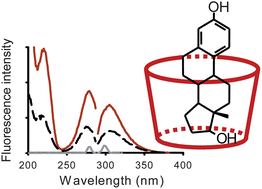Spectrofluorimetric study of estrogen–cyclodextrin inclusion complexes in aqueous systems
Abstract
For the first time, the spectrofluorimetric properties of

* Corresponding authors
a
Instituto de Química Rosario (CONICET-UNR), Facultad de Ciencias Bioquímicas y Farmacéuticas, Universidad Nacional de Rosario, Suipacha 531, 2000 Rosario, Argentina
E-mail:
escandar@iquir-conicet.gov.ar
For the first time, the spectrofluorimetric properties of

 Please wait while we load your content...
Something went wrong. Try again?
Please wait while we load your content...
Something went wrong. Try again?
R. L. Pérez and G. M. Escandar, Analyst, 2013, 138, 1239 DOI: 10.1039/C2AN36395J
To request permission to reproduce material from this article, please go to the Copyright Clearance Center request page.
If you are an author contributing to an RSC publication, you do not need to request permission provided correct acknowledgement is given.
If you are the author of this article, you do not need to request permission to reproduce figures and diagrams provided correct acknowledgement is given. If you want to reproduce the whole article in a third-party publication (excluding your thesis/dissertation for which permission is not required) please go to the Copyright Clearance Center request page.
Read more about how to correctly acknowledge RSC content.
 Fetching data from CrossRef.
Fetching data from CrossRef.
This may take some time to load.
Loading related content
